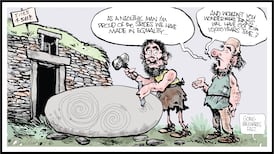Imagine if, on the radio, you hear about a heatwave coming. But instead of putting away your winter bedclothes in favour of a cotton sheet, you reach for a duvet that is tog 756.
Not unlike the tog value measurement, “global warming potential” is an index that describes the ability of different greenhouse gases (GHGs) to trap heat. Carbon dioxide, the most common GHG, is the reference gas. But methane, CH4 - representing 29 per cent of Ireland’s emissions, and about 16 per cent globally - breaks down more quickly but has a warming potential 84 times more potent than CO2 over a 20-year period.
Due to this powerful, relatively shorter-term, warming potential, strategies to reduce methane emissions are described by the European Environment Agency as the key to immediate action on climate change. Methane is a climate pollutant that, in addition to its huge warming potential, contributes to ground-level ozone, which, according to the United Nations Environment Programme (UNEP), causes a million premature deaths annually, suppresses crop growth, damages ecosystems, and has accounted for roughly 30 per cent of global warming from pre-industrial times.
The part played by what we eat, and what we don’t, in the damage caused by methane emissions is enough to give you night sweats. Our food system is predominantly responsible for human-caused methane emissions. According to a 2021 joint assessment by the UNEP and the Climate and Clean Air Coalition, 40 per cent of global human-made methane emissions come from agriculture (particularly livestock digestion and rice cultivation). Across the EU, half of methane emissions came from agriculture, while in Ireland, a farming country with high levels of beef and dairy farming, 94.5 per cent of our total CH4 emissions come from agriculture.
How a hotter world is affecting Ireland in five graphics
Connemara offshore wind farm will not go ahead, dealing blow to Government’s climate targets
Paludiculture could see Ireland’s peatlands store vast amounts of carbon and yield profit
Farmers and urban dwellers equally worried by climate change and willing to act, ESRI study finds
A further source of methane emissions is waste. Decomposing waste causes about 20 per cent of global methane emissions. Food waste is a component of this; in landfill it breaks down without oxygen (anaerobically), releasing methane. According to the Food and Agriculture Organisation, 8-10 per cent of all anthropogenic emissions are caused by food waste, and it has been estimated that 1.6 per cent of these are from methane.
Agricultural adaptation and food-waste prevention are therefore two crucial pillars in the strategy to effectively reduce methane emissions and make significant strides in combating climate change.
Launched at COP26 in Glasgow , the Global Methane Pledge is a voluntary agreement that sits within the United Nations framework. Participants including Ireland have pledged to take voluntary action to collectively reduce CH4 emissions by at least 30 per cent by 2030 compared with 2020 levels. (Unfortunately, major methane polluters India, China and Russia are not participants.) Meanwhile the latest UN climate change conference, COP 28, was nicknamed “food COP” because for the first time there was an official “food day” as part of the programme. Although the outcome of the fossil-fuel negotiations was less than satisfactory, there was a significant improvement in focus on the link between food systems and climate change in general, and the impact of our food system – and food loss and waste – on methane emissions in particular. Clear connections between measures to avoid food loss or waste and faster climate mitigation actions were highlighted. Investing in policies and hardware that avoid good food being wasted (such as surplus food recovery and redistribution, better supply chains, and better logistics) avoids wasting the methane emissions involved in producing it. But it also saves the methane emissions caused by decomposition – and contributes to reducing hunger.
At home, the European Union (Household Food Waste and Bio-waste)(Amendment) Regulations 2023 mean that since the beginning of the year, Irish waste collectors are obliged to provide a “brown” or organic waste bin to all households (with the exception of offshore islands). Before then, waste collectors were obliged to provide a brown bin only to households where there was a cluster of more than 500 houses. All households are obliged to separate their food waste so it can either be composted or used for anaerobic digestion (where the methane is captured for use). This legislation will further improve the separation of waste and reduce emissions.
The good news is that the UNEP notes behaviour change will be instrumental in reducing methane emissions, whether it’s choosing more plant-based foods or avoiding food waste.
We can all sleep better knowing we’ve avoided unnecessary food waste. Planning ahead, purchasing wisely, thinking about portion sizes and using the freezer all make a difference. Where food waste can’t be avoided, disposing of it using the brown or organic waste bin or by home composting will help avoid methane emissions being released into the atmosphere.
Stop Food Waste Day is 1 March 2024. Take the EPA’s Stop Food Waste Challenge at stopfoodwaste.ie.
Angela Ruttledge is head of public engagement at Food Cloud














